Dynamic Spatial–Temporal Self-Attention Network for Traffic Flow Prediction
Abstract
1. Introduction
- (1)
- Insufficient modelling of spatial dependencies in traffic flow data.
- (2)
- Insufficient modelling of the dynamic spatial–temporal correlations in the traffic data.
- (1)
- This research proposed a new Dynamic Spatial–Temporal Self-Attention Network to solve the problem of insufficient dynamic spatial–temporal correlation modelling in the traffic flow prediction process;
- (2)
- Building upon the spatial self-attention mechanism, this methodology introduces two masking matrices to model the local and global spatial correlations in the data, respectively. Furthermore, a temporal self-attention module is employed to integrate dynamic temporal dependencies, thereby achieving effective modelling of the dynamic spatiotemporal dependencies in the traffic data;
- (3)
- The current investigation conducted extensive comparative experiments with 11 baseline methods on four real datasets. The experimental results demonstrate the validity and superiority of this model.
2. Related Work
2.1. Graph Convolution Network
2.2. Attention Mechanism
2.3. Traffic Flow Prediction
3. Preliminaries
4. Methodology
4.1. Embedding Layer
4.2. Spatial–Temporal Self-Attention Layer
4.2.1. Feature Augmentation Module
4.2.2. Spatial Self-Attention Module
4.2.3. Temporal Self-Attention Module
4.3. Output Layer
4.4. Model Training Strategy
5. Experiments
5.1. Datasets
5.2. Baselines
- Vector Autoregression Model (VAR) [56]: The model first assumes a smooth historical time series state and then accomplishes the forecasting task by estimating the relationship between the time series and its lagged values;
- Autoregressive Integrated Moving Average Model (ARIMA) [19]: The model extracts the time series patterns hidden in the data by means of data autocorrelation and differencing, and then completes the prediction task through these patterns;
- Fully Connected Long Short-Term Memory Model (FC-LSTM) [67]: A Long Short-Term Memory network model with fully connected hidden units that can effectively capture dependencies in time series data;
- Diffusion Convolutional Recurrent Neural Network (DCRNN) [4]: The model integrates the features of bidirectional diffusion graph convolution and Recurrent Neural Networks to predict traffic flow accurately;
- Graph WaveNet [37]: The model adopts a hierarchical composition of Gate TCN (Temporal Convolutional Network) modules and GCN (Graph Convolutional Network) modules to model the spatial–temporal correlations in the traffic data effectively;
- Spatial–Temporal Graph Convolutional Networks (STGCNs) [2]: The model integrates Chebyshev graph convolution with 1D temporal convolution to effectively capture comprehensive spatial–temporal dependency features in the traffic data;
- Spatial–Temporal Fusion Graph Neural Networks (STFGNNs) [39]: The model leverages the fusion of spatial graphs and temporal graphs to capture hidden spatiotemporal dependencies in the traffic data effectively;
- Dynamic Spatial–Temporal Aware Graph Neural Networks (DSTAGNNs) [44]: The model incorporates dynamic spatial–temporal perception graph and improved gate convolutional modules to capture the inherent spatiotemporal dynamic features of the traffic data effectively;
- Graph Multi-Attention Network (GMAN) [29]: The multilevel attention model captures the dynamic spatiotemporal dependencies in the traffic data by stacking various attention modules, including spatial attention, temporal attention, and self-attention;
- Spatial–Temporal Graph Neural Controlled Differential Equations (STG-NCDEs) [59]: The temporal dynamics of the traffic data are modelled using the neural control differential equations, while leveraging the Graph Convolutional Networks to capture the spatial dependencies among different data points;
- Propagation Delay-aware Dynamic Long-range Transformer (PDFormer) [13]: The model utilises the self-attention mechanism to capture the dependencies in the traffic data. It introduces different graph mask matrices to model local spatial dependencies and global spatial dependencies separately. Additionally, the model incorporates a traffic delay perception feature module to address the issue of time delay in the spatial information propagation process.
5.3. Experimental Setups
5.4. Experiment Results
- (1)
- Methods incorporating neural networks, Graph Neural Networks, and attention mechanisms generally outperform traditional time series forecasting models such as VAR and ARIMA. This is attributed to the fact that traditional time series forecasting models often rely on static assumptions, which are insufficient for capturing the highly nonlinear spatial dependencies present in the traffic data. Consequently, these traditional models tend to overlook crucial information, resulting in an unsatisfactory prediction performance;
- (2)
- Graph Neural Network models, such as STGNN and Graph WaveNet, exhibit substantial advantages over neural network models like FC-LSTM and DCRNN in terms of prediction performance. This is attributed to the ability of Graph Neural Network models to effectively model both local and global spatial dependencies present in the traffic data, enabling them to capture a richer set of essential information compared to the aforementioned models. Furthermore, attention-based methods outperform Graph Neural Network-based methods. This can be attributed to the superior capability of attention mechanisms in integrating dynamic spatiotemporal dependencies present in the traffic data;
- (3)
- It is not universally true that methods based on Graph Neural Networks or attention mechanisms are always superior to other approaches. For instance, the STG-NCDE model, which combines neural controlled differential equations with Graph Convolutional Network models, exhibits comparable performance and competitiveness. This suggests that there is diversity in the solutions for the same problem, and different approaches can yield competitive results;
- (4)
- This model demonstrates a superior performance compared to other baseline methods for several reasons. Firstly, a comprehensive consideration of both local and global spatial dependencies is incorporated in the spatial dimension. Additionally, in the temporal dimension, this method accounts for the multi-periodicity of traffic flow. This holistic approach to spatial and temporal factors contributes to the improved performance of this model. Secondly, a feature augmentation layer is introduced that automatically adjusts the information interaction among different features. This feature augmentation facilitates the enhancement of representation capabilities for each feature dimension, resulting in an improved overall performance. Lastly, this model utilises two spatiotemporal attention modules to effectively capture and integrate the dynamic spatiotemporal dependencies present in the traffic data. This enables the model to accurately capture the complex patterns and relationships within the data, leading to more precise predictions.
5.5. Ablation Study
- (1)
- Variant FA: removal of the feature enhancement layer;
- (2)
- Variant Mh: spatial self-attention module using only the mask matrix, considering only local spatial dependencies;
- (3)
- Variant Ms: spatial self-attention module using only the mask matrix, considering only global spatial dependencies;
- (4)
- Variant TSA: removal of the temporal self-attention module.
- (1)
- The absence of any core module in the DSTSAN leads to a decrease in the model’s predictive performance, indicating that all core modules in the model capture key information to some extent;
- (2)
- The model exhibits the most significant decrease in predictive performance when only considering global spatial dependencies, indicating that local spatial dependencies have the greatest impact on the model’s predictive performance. Furthermore, this suggests that the traffic conditions at a road node are most influenced by the traffic conditions at its adjacent road nodes, aligning with the real-life observations;
- (3)
- In addition to local spatial correlations, global spatial correlations and dynamic temporal correlations are also crucial for influencing traffic flow.
5.6. Parameter Sensitivity Studies
6. Conclusions
Author Contributions
Funding
Data Availability Statement
Conflicts of Interest
References
- Wootton, J.R.; Garcia-Ortiz, A.; Amin, S.M. Intelligent Transportation Systems: A Global Perspective. Math. Comput. Model. 1995, 22, 4–7. [Google Scholar] [CrossRef]
- Yu, B.; Yin, H.; Zhu, Z. Spatio-Temporal Graph Convolutional Networks: A Deep Learning Framework for Traffic Forecasting. In Proceedings of the 27th International Joint Conference on Artificial Intelligence (IJCAI), Stockholm, Sweden, 13–19 July 2018. [Google Scholar] [CrossRef]
- Wei, H.; Zheng, G.; Yao, H.; Li, Z.J. IntelliLight: A Reinforcement Learning Approach for Intelligent Traffic Light Control. In Proceedings of the 24th ACM SIGKDD International Conference on Knowledge Discovery & Data Mining, London, UK, 19–23 August 2018. [Google Scholar]
- Li, Y.; Yu, R.; Shahabi, C.; Liu, Y. Diffusion Convolutional Recurrent Neural Network: Data-Driven Traffic Forecasting. arXiv 2017, arXiv:1707.01926. [Google Scholar] [CrossRef]
- Huang, C.; Zhang, C.; Dai, P.; Bo, L. Cross-Interaction Hierarchical Attention Networks for Urban Anomaly Prediction. In Proceedings of the Twenty-Ninth International Conference on International Joint Conferences on Artificial Intelligence, Online, 7–15 January 2021. [Google Scholar]
- Tedjopurnomo, D.A.; Bao, Z.; Zheng, B.; Choudhury, F.M.; Qin, A.K. A Survey on Modern Deep Neural Network for Traffic Prediction: Trends, Methods, and Challenges. IEEE Trans. Knowl. Data Eng. 2020, 34, 1544–1561. [Google Scholar] [CrossRef]
- Wu, Y.; Tan, H. Short-term Traffic Flow Forecasting with Spatial-temporal Correlation in a Hybrid Deep Learning Framework. arXiv 2016, arXiv:1612.01022. [Google Scholar] [CrossRef]
- Medina-Salgado, B.; Sánchez-DelaCruz, E.; Pozos-Parra, P.; Sierra, J.E. Urban Traffic Flow Prediction Techniques: A Review. Sustain. Comput. Inform. Syst. 2022, 35, 100739. [Google Scholar] [CrossRef]
- He, S.; Shin, K.G. Towards Fine-grained Flow Forecasting: A Graph Attention Approach for Bike Sharing Systems. In Proceedings of the Web Conference 2020, Taipei, Taiwan, 20–24 April 2020. [Google Scholar]
- Rao, X.; Wang, H.; Zhang, L.; Li, J.; Shang, S.; Han, P. FOGS: First-Order Gradient Supervision with Learning-based Graph for Traffic Flow Forecasting. In Proceedings of the Thirty-First International Joint Conference on Artificial Intelligence (IJCAI-22), Vienna, Austria, 23–29 July 2022. [Google Scholar]
- Shao, Z.; Zhang, Z.; Wei, W.; Wang, F.; Xu, Y.; Cao, X.; Jensen, C.S. Decoupled Dynamic Spatial-Temporal Graph Neural Network for Traffic Forecasting. Proc. VLDB Endow. 2022, 15, 2733–2746. [Google Scholar] [CrossRef]
- Lee, H.; Park, C.; Jin, S.; Chu, H.; Choo, J.; Ko, S. An Empirical Experiment on Deep Learning Models for Predicting Traffic Data. In Proceedings of the 2021 IEEE 37th International Conference on Data Engineering (ICDE), Chania, Greece, 19–22 April 2021; pp. 1817–1822. [Google Scholar]
- Jiang, J.; Han, C.; Zhao, W.X.; Wang, J. PDFormer: Propagation Delay-aware Dynamic Long-range Transformer for Traffic Flow Prediction. In Proceedings of the AAAI Conference on Artificial Intelligence, Washington, DC, USA, 7–14 February 2023. [Google Scholar]
- Wu, J.; Fu, J.C.; Ji, H.; Liu, L. Graph Convolutional Dynamic Recurrent Network with Attention for Traffic Forecasting. Appl. Intell. 2023, 53, 22002–22016. [Google Scholar] [CrossRef]
- Navarro-Espinoza, A.; López-Bonilla, O.R.; García-Guerrero, E.E.; Tlelo-Cuautle, E.; López-Mancilla, D.; Hernández-Mejía, C.; Inzunza-González, E. Traffic Flow Prediction for Smart Traffic Lights Using Machine Learning Algorithms. Technologies 2022, 10, 5. [Google Scholar] [CrossRef]
- Singh, A.; Yadav, A.; Rana, A.K. K-means with Three Different Distance Metrics. Int. J. Comput. Appl. 2013, 67, 10. [Google Scholar] [CrossRef]
- Cascetta, E. Transportation Systems Engineering: Theory and Methods; Springer: Berlin/Heidelberg, Germany, 2001. [Google Scholar]
- Li, F.; Feng, J.; Yan, H.; Jin, G.; Jin, D.; Li, Y. Dynamic Graph Convolutional Recurrent Network for Traffic Prediction: Benchmark and Solution. ACM Trans. Knowl. Discov. Data 2021, 17, 1–21. [Google Scholar] [CrossRef]
- Kumar, S.V.; Vanajakshi, L.D. Short-term Traffic Flow Prediction Using Seasonal ARIMA Model with Limited Input Data. Eur. Transport Res. Rev. 2015, 7, 1–9. [Google Scholar] [CrossRef]
- Cho, K.; Merrienboer, B.V.; Bahdanau, D.; Bengio, Y. On the Properties of Neural Machine Translation: Encoder–Decoder Approaches. arXiv 2014, arXiv:1409.1259. [Google Scholar]
- Wu, C.-H.; Ho, J.-M.; Lee, D.T. Travel-time Prediction with Support Vector Regression. IEEE Trans. Intell. Transp. Syst. 2004, 5, 276–281. [Google Scholar] [CrossRef]
- Dong, X.; Lei, T.; Jin, S.; Hou, Z. Short-Term Traffic Flow Prediction Based on XGBoost. In Proceedings of the 2018 IEEE 7th Data Driven Control and Learning Systems Conference (DDCLS), Enshi, China, 25–27 May 2018; pp. 854–859. [Google Scholar]
- Bai, L.; Yao, L.; Kanhere, S.S.; Yang, Z.; Chu, J.; Wang, X. Passenger Demand Forecasting with Multi-Task Convolutional Recurrent Neural Networks. In Proceedings of the Pacific-Asia Conference on Knowledge Discovery and Data Mining, Macau, China, 14–17 April 2019. [Google Scholar]
- Bai, L.; Yao, L.; Li, C.; Wang, X.; Wang, C. Adaptive Graph Convolutional Recurrent Network for Traffic Forecasting. In Proceedings of the 34th Conference on Neural Information Processing Systems (NeurIPS 2020), Online, 6–12 December 2020; Curran Associates Inc.: Red Hook, NY, USA, 2020. Article 1494. pp. 17804–17815. [Google Scholar]
- Chen, Y.; Segovia, I.; Gel, Y.R. Z-GCNETs: Time Zigzags at Graph Convolutional Networks for Time Series Forecasting. In Proceedings of the International Conference on Machine Learning, Online, 18–24 July 2021; pp. 1684–1694. [Google Scholar]
- Hochreiter, S.; Schmidhuber, J. Long Short-Term Memory. Neural Comput. 1997, 9, 1735–1780. [Google Scholar] [CrossRef] [PubMed]
- Chung, J.; Gulcehre, C.; Cho, K.; Bengio, Y. Empirical Evaluation of Gated Recurrent Neural Networks on Sequence Modeling. In NIPS 2014 Workshop on Deep Learning; Elsevier: Amsterdam, The Netherlands, 2014. [Google Scholar]
- Guo, S.; Lin, Y.; Feng, N.; Song, C.; Wan, H. Attention Based Spatial-Temporal Graph Convolutional Networks for Traffic Flow Forecasting. Proc. AAAI Conf. Artif. Intell. 2019, 33, 922–929. [Google Scholar] [CrossRef]
- Zheng, C.; Fan, X.; Wang, C.; Qi, J. GMAN: A Graph Multi-Attention Network for Traffic Prediction. Proc. AAAI Conf. Artif. Intell. 2020, 34, 1234–1241. [Google Scholar] [CrossRef]
- Wu, Z.; Pan, S.; Long, G.; Jiang, J.; Chang, X.; Zhang, C. Connecting the Dots: Multivariate Time Series Forecasting with Graph Neural Networks. In Proceedings of the 26th ACM SIGKDD International Conference on Knowledge Discovery & Data Mining, Virtual Event, 23–27 August 2020. [Google Scholar]
- Zhang, Q.; Chang, J.; Meng, G.; Xiang, S.; Pan, C. Spatio-Temporal Graph Structure Learning for Traffic Forecasting. Proc. AAAI Conf. Artif. Intell. 2020, 34, 1177–1185. [Google Scholar] [CrossRef]
- Huang, R.; Huang, C.; Liu, Y.; Dai, G.; Kong, W. LSGCN: Long Short-Term Traffic Prediction with Graph Convolutional Networks. In Proceedings of the Twenty-Ninth International Joint Conference on Artificial Intelligence (IJCAI-20), Yokohama, Japan, 7–15 January 2021. [Google Scholar]
- Pinaya, W.H.L.; Vieira, S.; Garcia-dias, R.; Mechelli, A. Convolutional Neural Networks; Machine learning; Academic Press: Cambridge, MA, USA, 2020; pp. 173–191. [Google Scholar]
- Scarselli, F.; Gori, M.; Tsoi, A.C.; Hagenbuchner, M.; Monfardini, G. The Graph Neural Network Model. IEEE Trans. Neural Netw. 2009, 20, 61–80. [Google Scholar] [CrossRef] [PubMed]
- Zhou, J.; Cui, G.; Hu, S.; Zhang, Z.; Yang, C.; Liu, Z.; Wang, L.; Li, C.; Sun, M. Graph Neural Networks: A Review of Methods and Applications. AI Open 2020, 1, 57–81. [Google Scholar] [CrossRef]
- Wu, Z.; Pan, S.; Chen, F.; Long, G.; Zhang, C.; Yu, P.S. A Comprehensive Survey on Graph Neural Networks. IEEE Trans. Neural Netw. Learn. Syst. 2019, 32, 4–24. [Google Scholar] [CrossRef]
- Wu, Z.; Pan, S.; Long, G.; Jiang, J.; Zhang, C. Graph WaveNet for Deep Spatial-Temporal Graph Modeling. In Proceedings of the Twenty-Eighth International Joint Conference on Artificial Intelligence (IJCAI-19), Macao, China, 10–16 August 2019. [Google Scholar]
- Rahmani, S.; Baghbani, A.; Bouguila, N.; Patterson, Z. Graph Neural Networks for Intelligent Transportation Systems: A Survey. IEEE Trans. Intell. Transp. Syst. 2023, 24, 8846–8885. [Google Scholar] [CrossRef]
- Li, M.; Zhu, Z. Spatial-temporal Fusion Graph Neural Networks for Traffic Flow Forecasting. Proc. AAAI Conf. Artif. Intell. 2021, 35, 4189–4196. [Google Scholar] [CrossRef]
- Seo, Y.; Defferrard, M.; Vandergheynst, P.; Bresson, X. Structured Sequence Modeling with Graph Convolutional Recurrent Networks. In Neural Information Processing: Proceedings of the 25th International Conference, ICONIP 2018, Siem Reap, Cambodia, 13–16 December 2018; Proceedings, Part I; Springer International Publishing: Berlin/Heidelberg, Germany, 2018; pp. 362–373. [Google Scholar]
- Yan, S.; Xiong, Y.; Lin, D. Spatial Temporal Graph Convolutional Networks for Skeleton-Based Action Recognition. Proc. AAAI Conf. Artif. Intell. 2018, 32, 1. [Google Scholar] [CrossRef]
- Kipf, T.N.; Welling, M. Semi-Supervised Classification with Graph Convolutional Networks. arXiv 2016, arXiv:1609.02907. [Google Scholar] [CrossRef]
- Defferrard, M.; Bresson, X.; Vandergheynst, P. Convolutional Neural Networks on Graphs with Fast Localized Spectral Filtering. In Proceedings of the 30th Conference on Neural Information Processing Systems (NIPS 2016), Barcelona, Spain, 5–10 December 2016. [Google Scholar]
- Lan, S.; Ma, Y.; Huang, W.; Wang, W.; Yang, H.; Li, P. DSTAGNN: Dynamic Spatial-Temporal Aware Graph Neural Network for Traffic Flow Forecasting. In Proceedings of the 39th International Conference on Machine Learning, Baltimore, MD, USA, 17–23 July 2022. [Google Scholar]
- Liu, H.; Zhu, C.; Zhang, D.; Li, Q. Attention-based Spatial-Temporal Graph Convolutional Recurrent Networks for Traffic Forecasting. In Proceedings of the International Conference Advanced Data Mining and Applications, Shenyang, China, 21–23 August 2023. [Google Scholar]
- Bruna, J.; Zaremba, W.; Szlam, A.; LeCun, Y. Spectral Networks and Locally Connected Networks on Graphs. arXiv 2013, arXiv:1312.6203. [Google Scholar]
- Micheli, A. Neural Network for Graphs: A Contextual Constructive Approach. IEEE Trans. Neural Netw. 2009, 20, 498–511. [Google Scholar] [CrossRef] [PubMed]
- Jiang, W.; Luo, J. Graph Neural Network for Traffic Forecasting: A Survey. Expert Syst. Appl. 2022, 207, 117921. [Google Scholar] [CrossRef]
- Gilmer, J.; Schoenholz, S.S.; Riley, P.F.; Vinyals, O.; Dahl, G.E. Neural Message Passing for Quantum Chemistry. In Proceedings of the 34th International Conference on Machine Learning, Sydney, Australia, 6–11 August 2017. [Google Scholar]
- Hamilton, W.L.; Ying, Z.; Leskovec, J. Inductive Representation Learning on Large Graphs. In Proceedings of the Thirty-first Annual Conference on Neural Information Processing Systems (NIPS), Long Beach, CA, USA, 4–9 December 2017. [Google Scholar]
- Atwood, J.; Towsley, D.F. Diffusion-Convolutional Neural Networks. In Proceedings of the Annual Conference on Neural Information Processing Systems 2015, Montreal, QC, Canada, 7–12 December 2015. [Google Scholar]
- Velickovic, P.; Cucurull, G.; Casanova, A.; Romero, A.; Liò, P.; Bengio, Y. Graph Attention Networks. Stat 2017, 1050, 10–48550. [Google Scholar]
- Vaswani, A.; Shazeer, N.M.; Parmar, N.; Uszkoreit, J.; Jones, L.; Gomez, A.N.; Kaiser, L.; Polosukhin, I. Attention is All You Need. In Proceedings of the Thirty-first Annual Conference on Neural Information Processing Systems (NIPS), Long Beach, CA, USA, 4–9 December 2017. [Google Scholar]
- Zhou, H.; Zhang, S.; Peng, J.; Zhang, S.; Li, J.; Xiong, H.; Zhang, W. Informer: Beyond Efficient Transformer for Long Sequence Time-Series Forecasting. Proc. AAAI Conf. Artif. Intell. 2021, 35, 11106–11115. [Google Scholar] [CrossRef]
- Lai, G.; Chang, W.-C.; Yang, Y.; Liu, H. Modeling Long- and Short-Term Temporal Patterns with Deep Neural Networks. In Proceedings of the 41st International ACM SIGIR Conference on Research & Development in Information Retrieval, Ann Arbor, MI, USA, 8–12 July 2017. [Google Scholar]
- Zivot, E.; Wang, J. Vector Autoregressive Models for Multivariate Time Series. 2003. Available online: https://faculty.washington.edu/ezivot/econ584/notes/varModels.pdf (accessed on 21 April 2024).
- Williams, B.M.; Hoel, L.A. Modeling and Forecasting Vehicular Traffic Flow as a Seasonal ARIMA Process: Theoretical Basis and Empirical Results. J. Transp. Eng. 2003, 129, 664–672. [Google Scholar] [CrossRef]
- Huang, S.; Wang, D.; Wu, X.; Tang, A. DSANet: Dual Self-Attention Network for Multivariate Time Series Forecasting. In Proceedings of the 28th ACM International Conference on Information and Knowledge Management, Beijing China, 3–7 November 2019. [Google Scholar]
- Choi, J.; Choi, H.; Hwang, J.; Park, N. Graph Neural Controlled Differential Equations for Traffic Forecasting. Proc. AAAI Conf. Artif. Intell. 2022, 36, 6367–6374. [Google Scholar] [CrossRef]
- Fang, Z.; Long, Q.; Song, G.; Xie, K. Spatial-Temporal Graph ODE Networks for Traffic Flow Forecasting. In Proceedings of the 27th ACM SIGKDD Conference on Knowledge Discovery and Data Mining, Virtual Event, 14–18 August 2021. [Google Scholar]
- Jin, G.; Liu, L.; Li, F.; Huang, J. Spatio-Temporal Graph Neural Point Process for Traffic Congestion Event Prediction. Proc. AAAI Conf. Artif. Intell. 2023, 37, 14268–14276. [Google Scholar] [CrossRef]
- Berndt, D.J.; Clifford, J. Using Dynamic Time Warping to Find Patterns in Time Series. In Proceedings of the KDD Workshop, Seattle, WA, USA, 31 July–1 August 1994. [Google Scholar]
- Woo, S.; Park, J.; Lee, J.Y.; Kweon, I.S. CBAM: Convolutional Block Attention Module. In Proceedings of the 15th European Conference on Computer Vision, Munich, Germany, 8–14 September 2018; pp. 3–19. [Google Scholar]
- Keogh, E.J.; Pazzani, M.J. Derivative Dynamic Time Warping. In Proceedings of the 2001 SIAM International Conference on Data Mining, Chicago, IL, USA, 5–7 April 2001. [Google Scholar]
- Huber, P.J. Robust Estimation of a Location Parameter. Ann. Math. Stat. 1964, 35, 492–518. [Google Scholar] [CrossRef]
- Chen, C.; Petty, K.; Skabardonis, A.; Varaiya, P.; Jia, Z. Freeway performance measurement system: Mining loop detector data. Transp. Res. Rec. 2001, 1748, 96–102. [Google Scholar] [CrossRef]
- Sutskever, I.; Vinyals, O.; Le, Q.V. Sequence to Sequence Learning with Neural Networks. Adv. Neural Inf. Process. Syst. 2014, 27, 3104. Available online: https://proceedings.neurips.cc/paper_files/paper/2014/hash/a14ac55a4f27472c5d894ec1c3c743d2-Abstract.html (accessed on 21 May 2024).
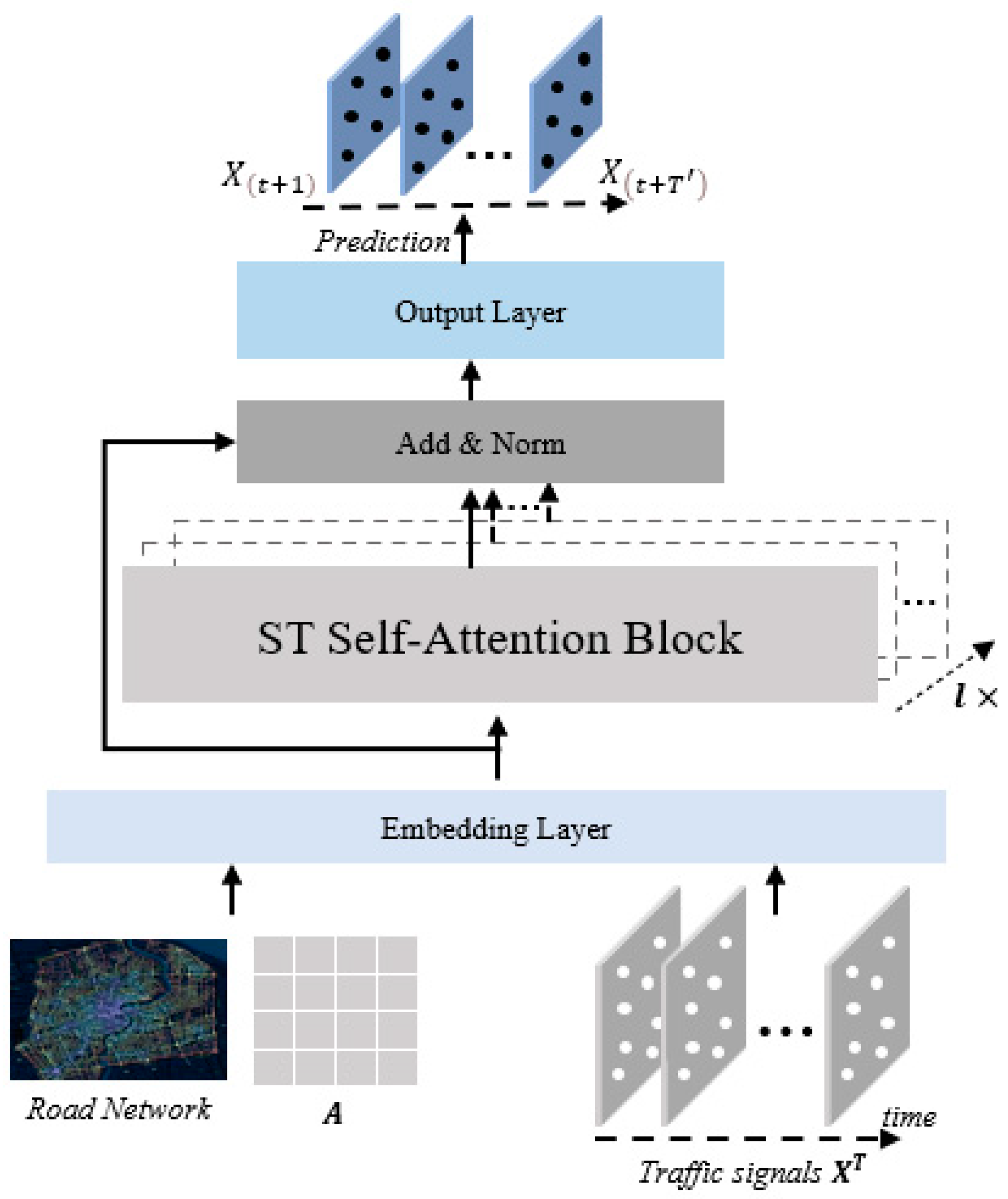
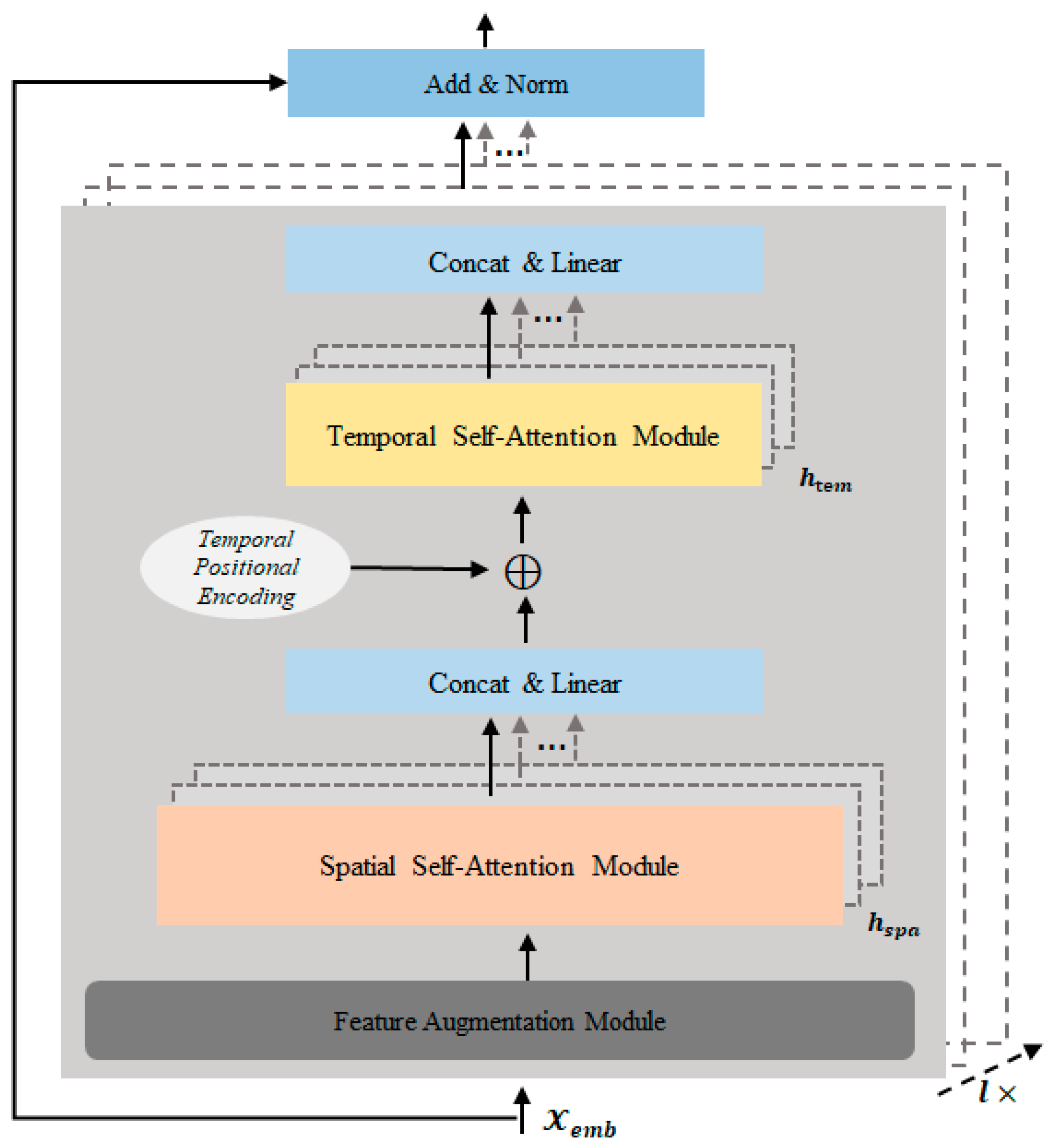

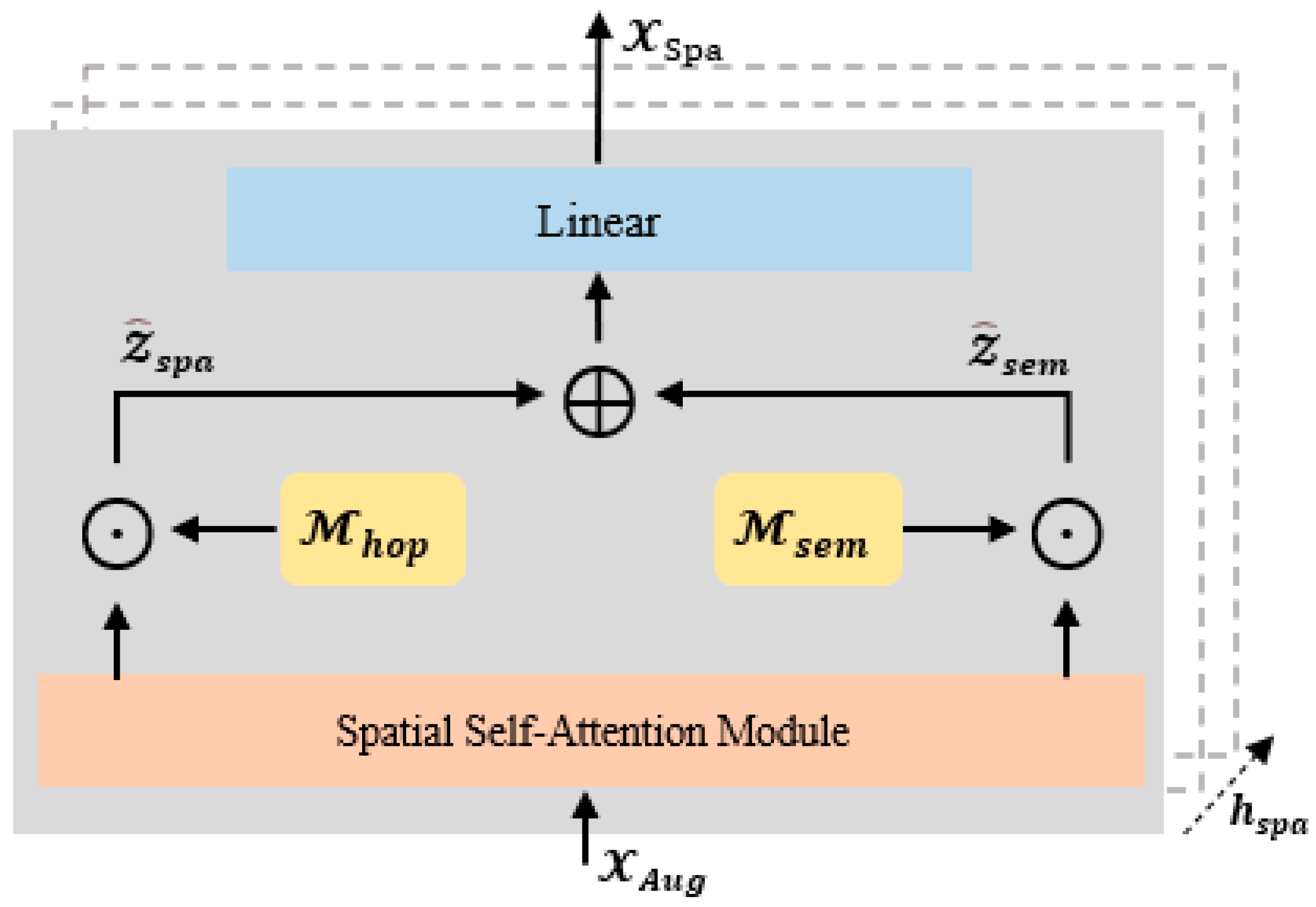
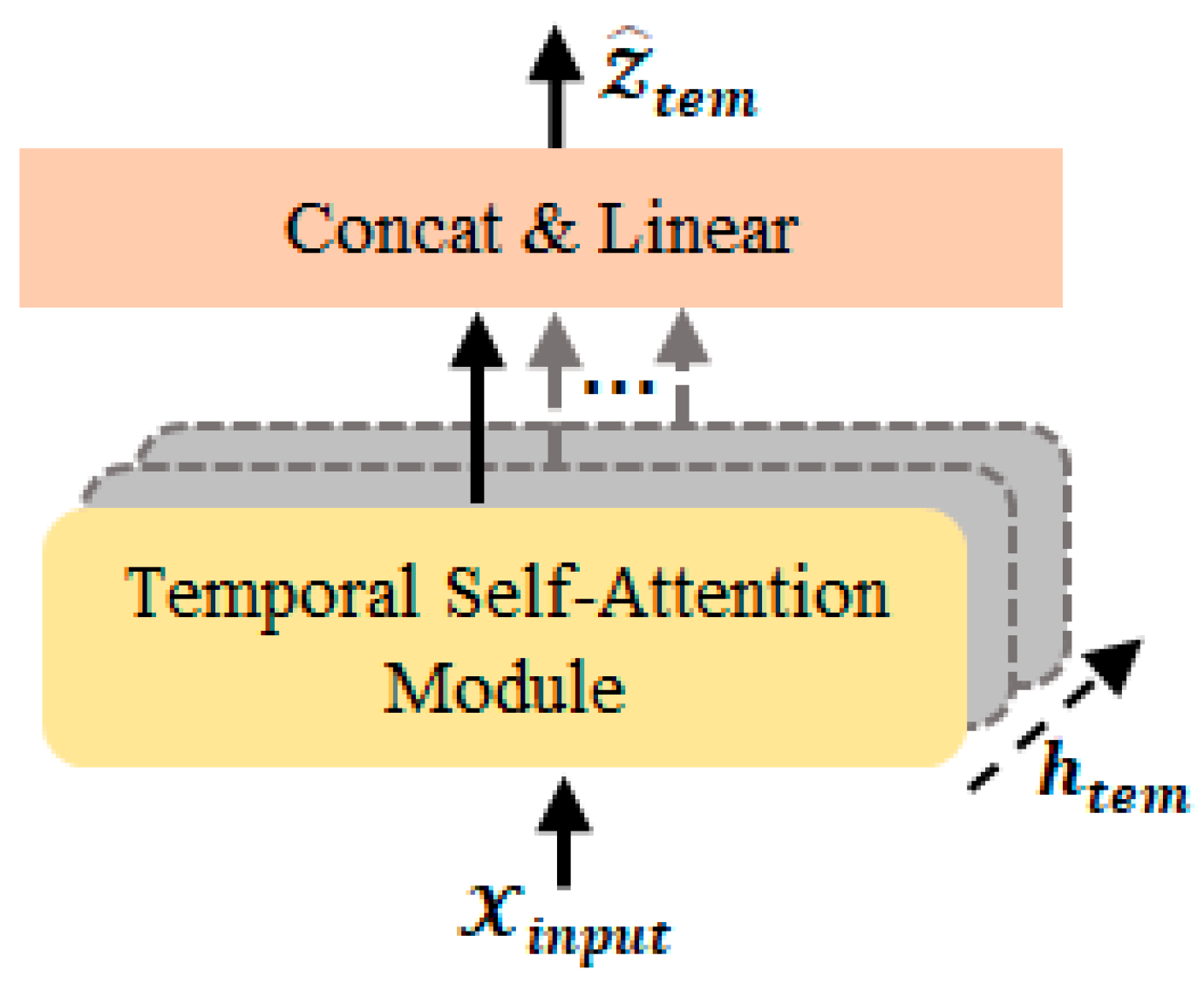
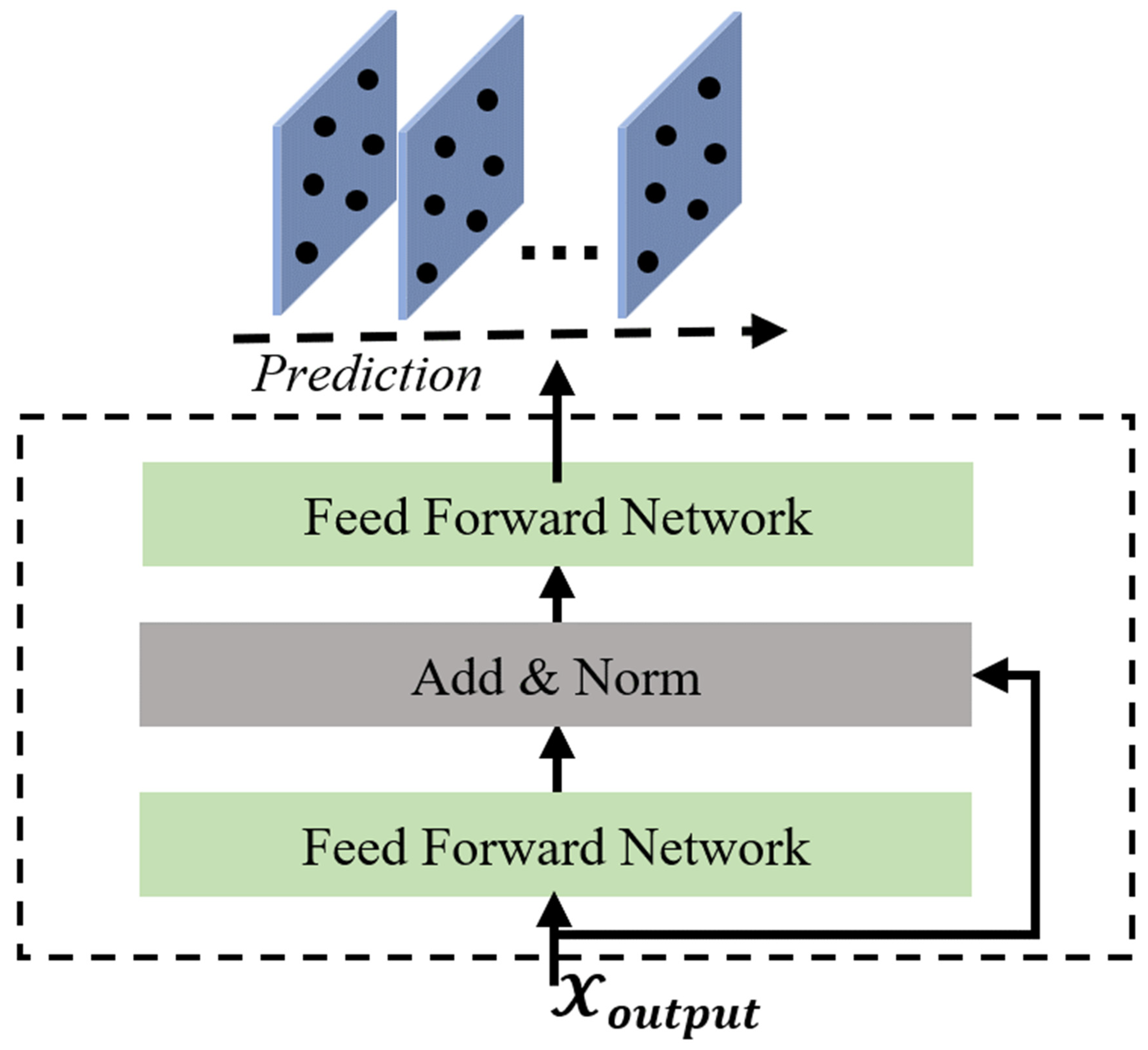
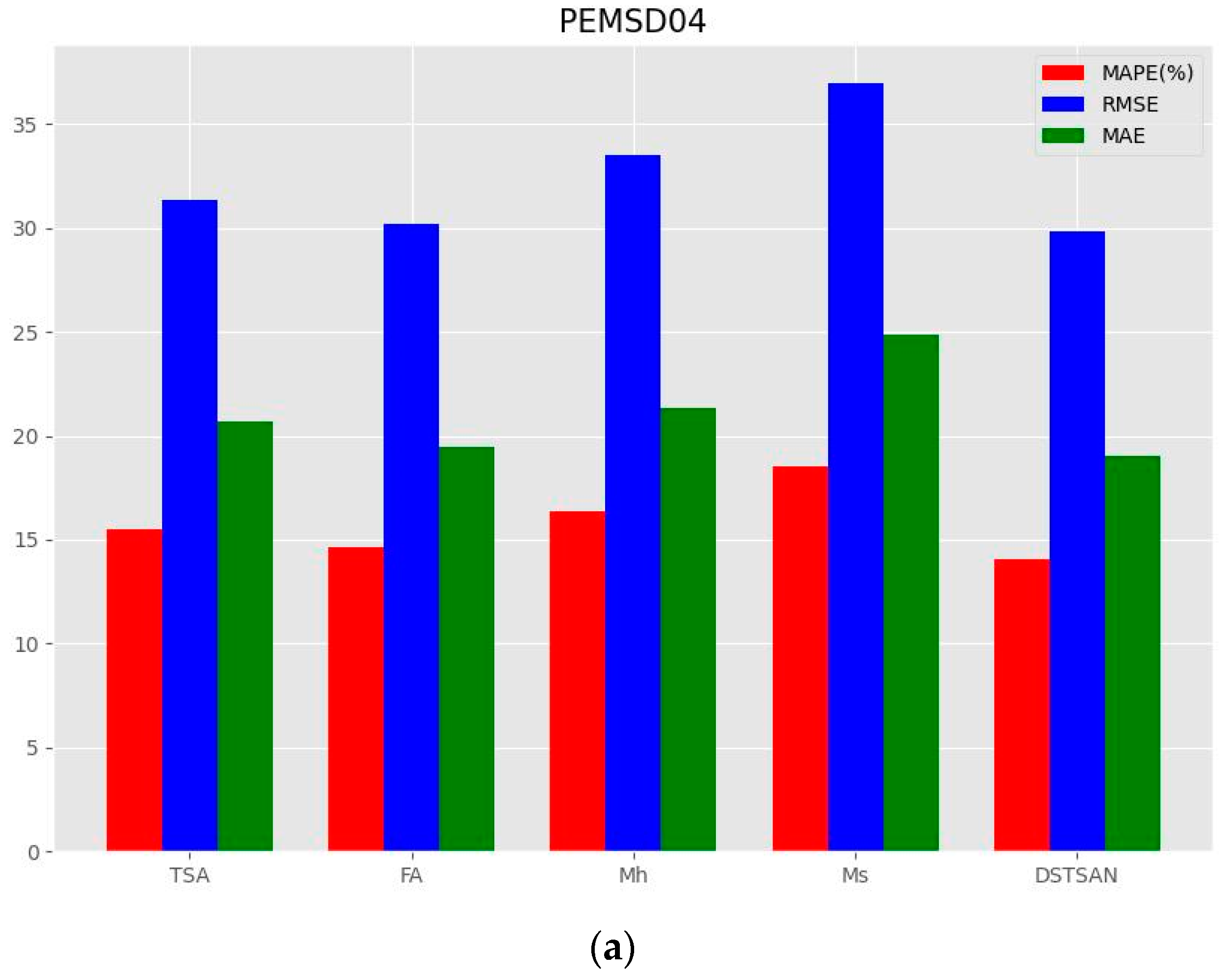
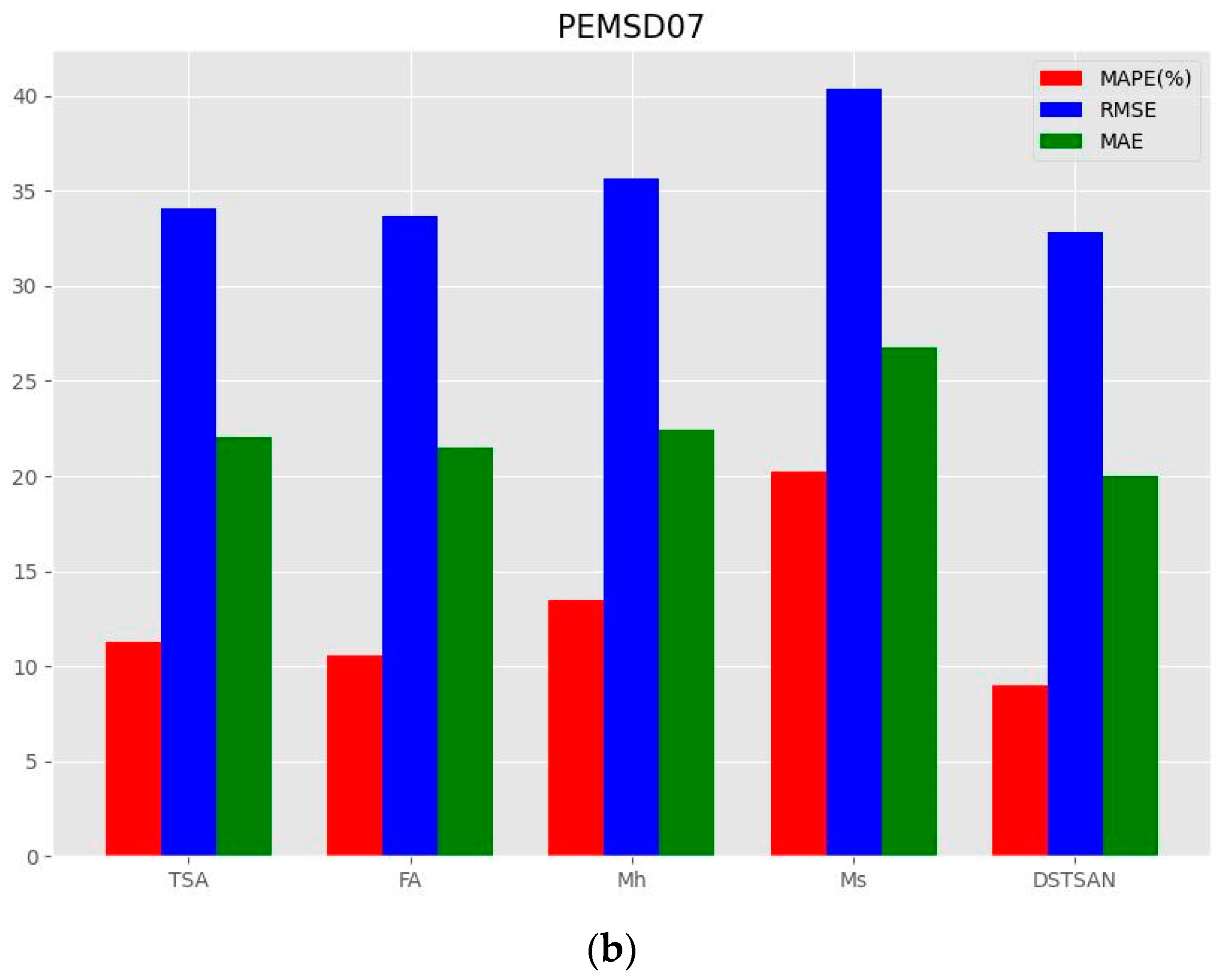
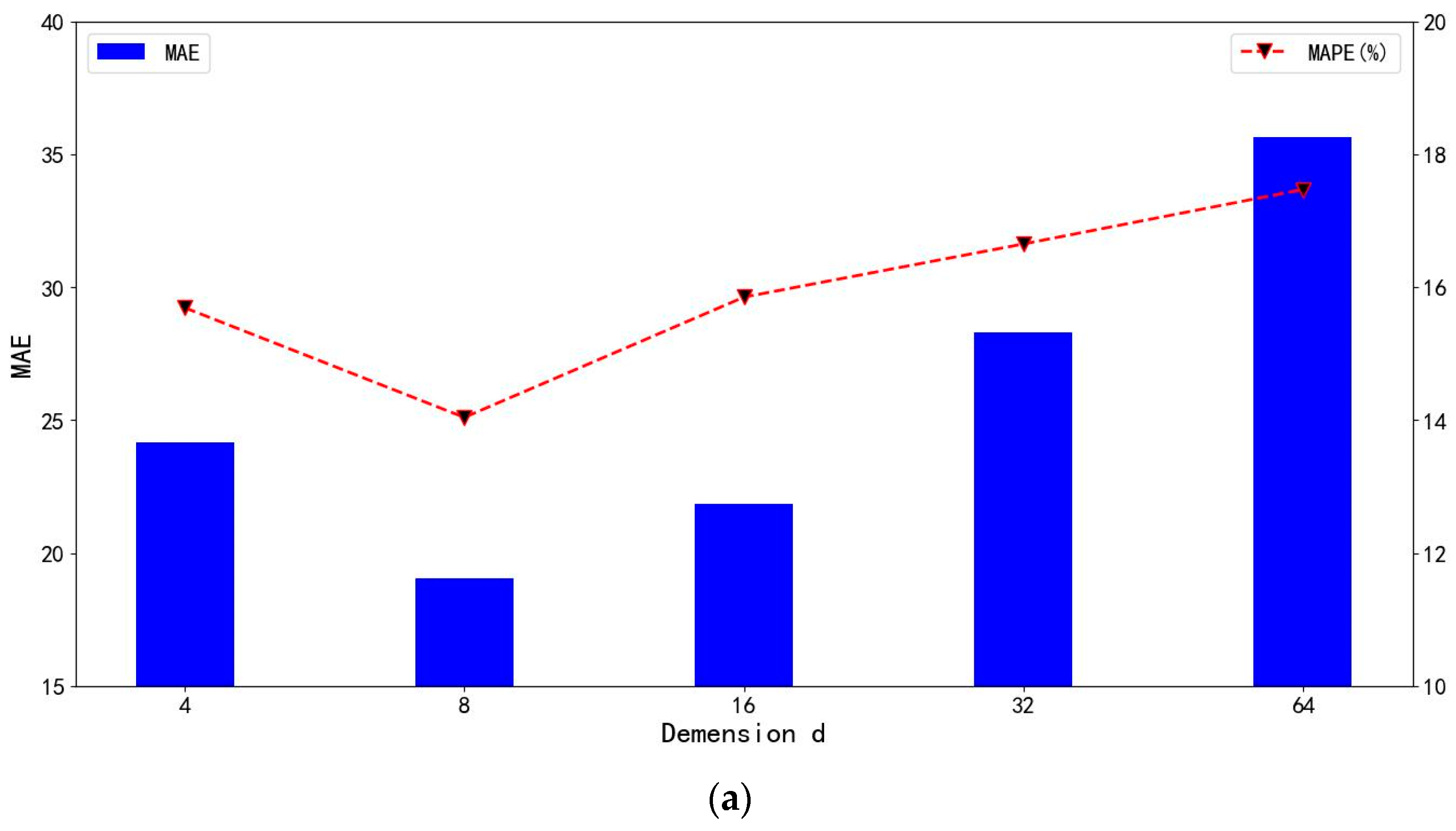
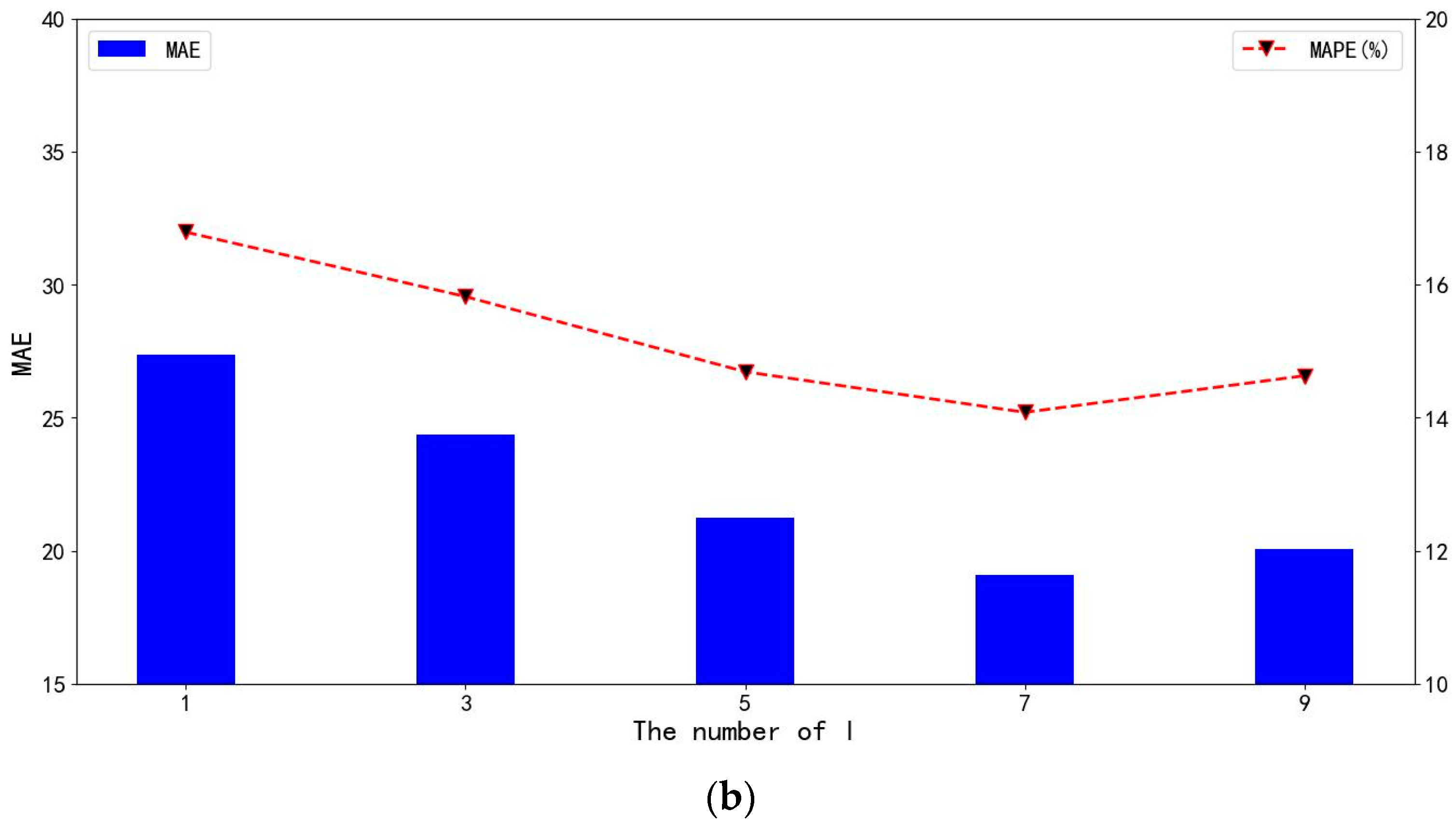
| Datasets | Nodes | Edges | Samples | Time Span |
|---|---|---|---|---|
| PEMS03 | 358 | 547 | 26,208 | 3 months |
| PEMS04 | 307 | 340 | 16,992 | 2 months |
| PEMS07 | 883 | 866 | 28,224 | 3 months |
| PEMS08 | 170 | 295 | 17,856 | 2 months |
| Model | PEMS03 | PEMS04 | PEMS07 | PEMS08 | ||||||||
|---|---|---|---|---|---|---|---|---|---|---|---|---|
| MAE | RMSE | MAPE | MAE | RMSE | MAPE | MAE | RMSE | MAPE | MAE | RMSE | MAPE | |
| VAR | 24.68 | 37.91 | 21.62% | 25.35 | 39.13 | 19.67% | 52.50 | 76.28 | 34.73% | 24.31 | 35.64 | 16.32% |
| ARIMA | 34.47 | 46.53 | 29.81% | 32.65 | 43.50 | 25.41% | 38.57 | 56.26 | 26.49% | 32.30 | 39.77 | 18.74% |
| FC-LSTM | 23.49 | 37.03 | 20.37% | 24.33 | 39.06 | 19.51% | 29.98 | 44.27 | 14.73% | 22.79 | 32.30 | 14.80% |
| DCRNN | 22.85 | 36.52 | 19.46% | 23.61 | 37.57 | 18.86% | 25.41 | 38.84 | 13.74% | 18.56 | 28.67 | 12.24% |
| STGCN | 21.40 | 34.83 | 18.91% | 22.98 | 36.41 | 18.20% | 25.67 | 38.92 | 13.27% | 18.18 | 27.83 | 12.06% |
| Graph WaveNet | 19.49 | 32.30 | 18.14% | 21.25 | 33.40 | 16.76% | 22.41 | 35.51 | 11.44% | 16.03 | 25.26 | 10.54% |
| STFGNN | 19.83 | 33.19 | 18.35% | 21.42 | 33.67 | 16.20% | 22.06 | 34.58 | 10.74% | 16.97 | 26.31 | 11.28% |
| GMAN | 17.77 | 29.07 | 16.46% | 20.70 | 32.07 | 15.80% | 21.83 | 34.32 | 10.05% | 15.50 | 24.95 | 10.83% |
| DSTAGNN | 17.81 | 29.23 | 16.33% | 20.42 | 31.90 | 15.34% | 21.67 | 34.30 | 9.83% | 15.86 | 24.61 | 10.34% |
| PDFormer | 16.57 | 27.66 | 15.90% | 19.64 | 30.65 | 14.31% | 20.38 | 33.56 | 9.27% | 14.83 | 23.05 | 9.84% |
| STG-NCDE | 17.75 | 28.92 | 16.60% | 20.21 | 31.74 | 15.48% | 21.42 | 34.04 | 9.71% | 15.79 | 24.83 | 10.29% |
| DSTSAN | 16.04 | 27.11 | 15.23% | 19.06 | 29.83 | 14.04% | 20.01 | 32.78 | 9.01% | 14.36 | 22.44 | 9.29% |
Disclaimer/Publisher’s Note: The statements, opinions and data contained in all publications are solely those of the individual author(s) and contributor(s) and not of MDPI and/or the editor(s). MDPI and/or the editor(s) disclaim responsibility for any injury to people or property resulting from any ideas, methods, instructions or products referred to in the content. |
© 2024 by the authors. Licensee MDPI, Basel, Switzerland. This article is an open access article distributed under the terms and conditions of the Creative Commons Attribution (CC BY) license (https://creativecommons.org/licenses/by/4.0/).
Share and Cite
Wang, D.; Yang, H.; Zhou, H. Dynamic Spatial–Temporal Self-Attention Network for Traffic Flow Prediction. Future Internet 2024, 16, 189. https://doi.org/10.3390/fi16060189
Wang D, Yang H, Zhou H. Dynamic Spatial–Temporal Self-Attention Network for Traffic Flow Prediction. Future Internet. 2024; 16(6):189. https://doi.org/10.3390/fi16060189
Chicago/Turabian StyleWang, Dong, Hongji Yang, and Hua Zhou. 2024. "Dynamic Spatial–Temporal Self-Attention Network for Traffic Flow Prediction" Future Internet 16, no. 6: 189. https://doi.org/10.3390/fi16060189
APA StyleWang, D., Yang, H., & Zhou, H. (2024). Dynamic Spatial–Temporal Self-Attention Network for Traffic Flow Prediction. Future Internet, 16(6), 189. https://doi.org/10.3390/fi16060189






